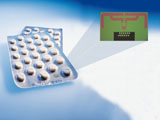First 24 GHz RFID-Transponder for identification

Together with industry partners, researchers at the Fraunhofer Institute for Photonic Microsystems (IPMS) have developed a novel RFID system which uses very high frequencies (Super High Frequency – SHF). The 24 GHz frequency band makes it possible to use very small antennas and integrate these antennas directly on the chip. Measuring merely 2.5×1.5 mm² and 150 μm thick, tags can be manufactured at low cost and should help in the future to cost-effectively distinguish high-quality mass products such as pharmaceuticals and auto parts as well as ID and credit cards in order to identify stolen property, counterfeit goods or forgeries.
Fraunhofer IPMS Group Leader Hans-Jürgen Holland explains, “Using frequencies in the SHF band provides the advantage of being able to use very small antennas. At 24 GHz, the free space wavelength is only 1.24 cm. Therefore, it is possible to integrate the antenna directly on the tag as an On-Chip Antenna (OCA). This eliminates the cost of packaging and assembly required by an external antenna and reduces the overall size of a complete RFID-Tag to a few square millimeters.”
Reader equipment to interpret serial numbers with which the product to be identified is assigned has been developed within the project consortium by metraTech GmbH. An electromagnetic field emitted by the reader produces the energy necessary for the operation of the chip, making a read range of a few millimeters possible. The chip follows a transmission protocol according to the ISO 18000-6c standard, also known as EPC C1G2. To keep production costs low, the system is manufactured in a standard CMOS technology.
The passively operated RFID-transponder with an integrated antenna can be easily incorporated into several products. Project partners are already busy working to develop and test methods for the rapid and cost-effective integration of RFID-Tags into labels, tickets for public transportation, admission tickets, stickers and smartcards.
This project was funded by the Federal Ministry of Education and Research (BMBF) under grant number 031PT501A. Results of the recently completed project will be presented to the professional public for the first time in a poster presentation and during an accompanying exhibition at the Fraunhofer IPMS Booth Number 13 at the Mikrosystemtechnik Kongress in Karlsruhe from 26-28 October 2015.
 Fraunhofer Institute for Photonic Microsystems
Fraunhofer Institute for Photonic Microsystems